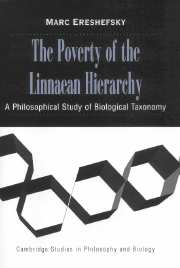5 - How to Be a Discerning Pluralist
Published online by Cambridge University Press: 16 July 2009
Summary
The last chapter ended with a challenge to the taxonomic pluralist in the form of the “anything goes” objection. Organisms can be sorted into numerous classifications. We can, for example, sort organisms into species according to breeding behavior, phylogenetic relations, size, color, even which organisms my son likes best. Species pluralists, however, do not propose that we accept every conceivable taxonomic project. Two reasons were offered in the previous chapter. The first reason is a cognitive one. Species pluralists believe that some taxonomic approaches have better epistemic credentials than others and therefore are more worthy of investigation.The business of biological taxonomy, they suggest, is to focus on the most empirically promising approaches. The second reason for restricting pluralism is more pragmatic. Society has only limited resources to dedicate to science and,in particular,to biological taxonomy. National granting agencies can fund only a minority of proposed projects. If pluralism provides no way of discerning among projects, then our scientific resources will be spread too thinly and no project will be investigated properly.The challenge to the pluralist, then, is to allow the investigation of a plurality of classifications while at the same time constraining which classifications should be pursued.
This chapter provides an answer to the “anything goes” objection by providing an account of how one can be a discerning pluralist.
Information
- Type
- Chapter
- Information
- The Poverty of the Linnaean HierarchyA Philosophical Study of Biological Taxonomy, pp. 163 - 196Publisher: Cambridge University PressPrint publication year: 2000
